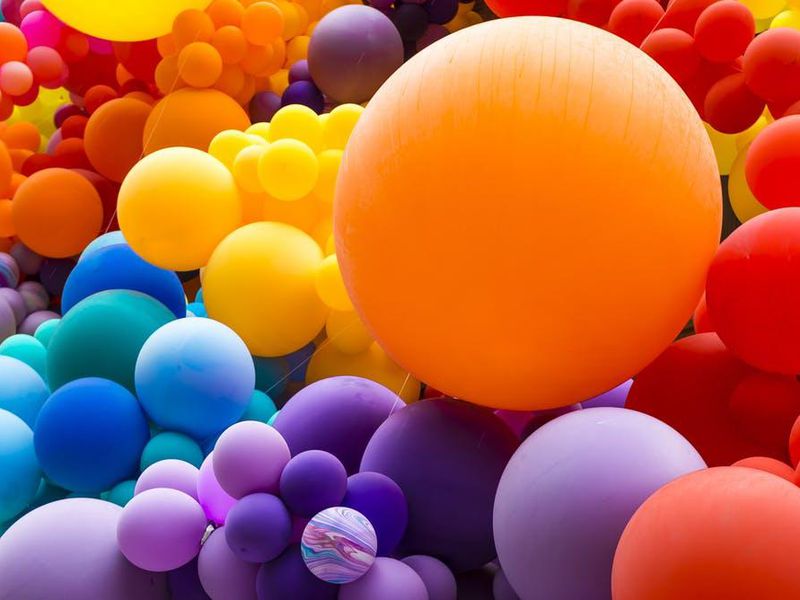Table of Contents
Reading Through Roy G Biv
RED
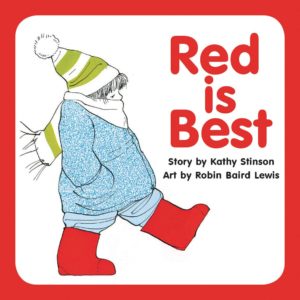 |
In Kathy Stinson’s Red is Best (Annick Press, 2006), everything red is best – red mittens, red stockings, red boots, red cups, and more. For ages 3-6. |
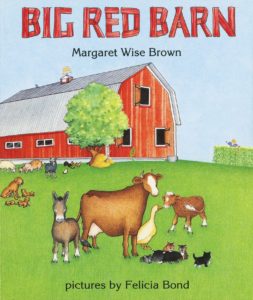 |
Margaret Wise Brown’s Big Red Barn (Baltzer + Bray, 1995) is a gently farmyard story filled with colors. (“By the big red barn/In the great green field/There was a pink pig/Who was learning to squeal.”) For ages 3-7. |
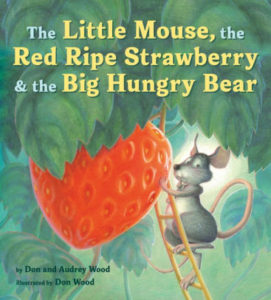 |
In Don and Audrey Wood’s The Little Mouse, the Red Ripe Strawberry, and the Big Hungry Bear (Clarion, 2020), a charmer of a mouse manages to pick and enormous red strawberry – but now must keep it from the Big Hungry Bear. For ages 3-7. |
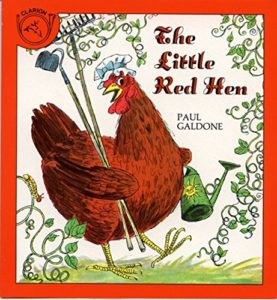 |
Paul Galdone’s The Little Red Hen (Clarion, 1985) is the story of the overworked Red Hen who bakes a cake without any help from Cat, Dog, or Mouse – until it comes time to eat the finished product. For ages 4-7. |
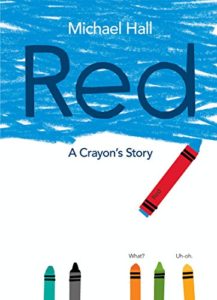 |
In Michael Hall’s Red: A Crayon’s Story (Greenwillow, 2015), a blue crayon is labeled as red – which leads to all kinds of complications. (He has a terrible time drawing strawberries.) A story of self-discovery for ages 4-8. |
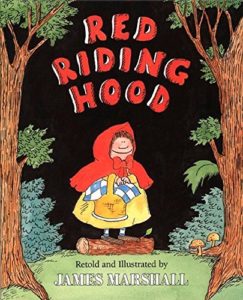 |
There are many versions of the story of Red Riding Hood, the little girl who sets off with a basket to visit her grandmother and runs into a wolf – but in all of them, she wears a bright-red cape with a hood. See James Marshall’s Red Riding Hood (Picture Puffins, 1993). For ages 4-8. |
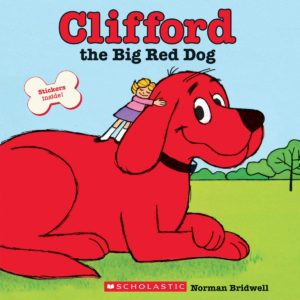 |
In Norman Bridwell’s Clifford the Big Red Dog (Scholastic, 2010), Emily’s dog is REALLY BIG. And very red. Many sequels. For ages 4-8. |
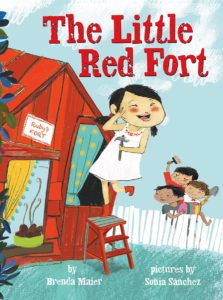 |
In Brenda Maier’s The Little Red Fort (Scholastic, 2018), Ruby finds some boards and wants to build a fort – though her brothers won’t help. Ruby, instead, finds out how to build a fort on her own – with such great results that her brothers finally pitch in, planting flowers and painting the fort red. For ages 4-8. |
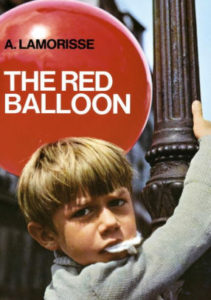 |
By Albert Lamorisse, The Red Balloon (Doubleday, 1967) is the story of Pascal, a lonely little boy in Paris, and his best friend: a magical red balloon. Illustrated with photographs. For ages 4-8. |
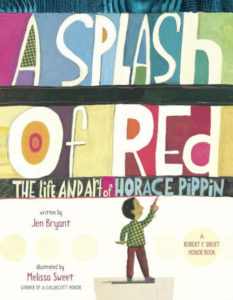 |
By Jen Bryant with amazing illustrations by Melissa Sweet, A Splash of Red (Knopf, 2013) is a picture-book biography of African-American artist Horace Pippin. For ages 5-8. Hear Jen Bryant read A Splash of Red here. |
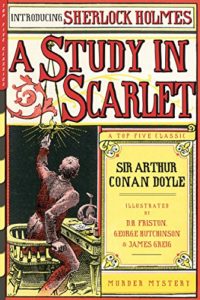 |
Arthur Conan Doyle’s A Study in Scarlet, first published in 1887, is the first to feature Sherlock Holmes and sidekick Dr. Watson, soon to be the most famous detective pair in literature. Available in many editions. |
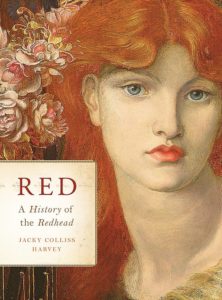 |
Are you a ginger? By Jacky Colliss Harvey, Red (Black Dog & Leventhal, 2015) is a history of red hair and red heads – beginning with a gene mutation that popped up about 30,000 years ago. For teens and adults. |
ORANGE
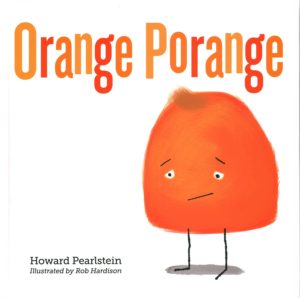 |
By Howard Pearlstein, in Orange Porange (Marshall Cavendish, 2020), all the colors have rhymes – except poor Orange. For ages 3-6. |
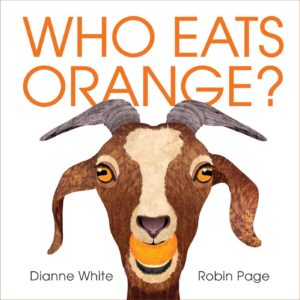 |
By Dianne White, Who Eats Orange? (Beach Lane Books, 2018) is an exploration of color through animals’ favorite foods. (Rabbits, chickens, and goats eat orange; gorillas, giraffes, and zebras eat green.) For ages 3-7. |
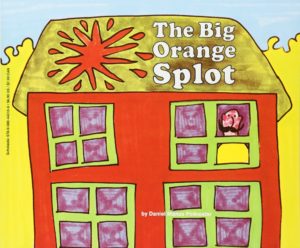 |
In Daniel Pinkwater’s The Big Orange Splot, all the houses on Mr. Plumbeam’s street look just the same – until a seagull dropped a can of orange paint on Mr. Plumbean’s roof, creating a big orange splot. It’s the beginning of an artistic explosion. For ages 4-8. |
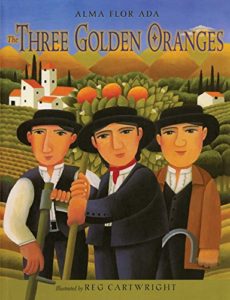 |
By Alma Flor Ada, The Three Golden Oranges (Atheneum, 2012) is a retelling of a Spanish folk tale in which three brothers wish to find brides. They seek the advice of an old woman who sends them to a distant castle to pick three golden oranges and bring them to her – and then each will find the wife he desires. But only if they follow her advice. For ages 5-8. |
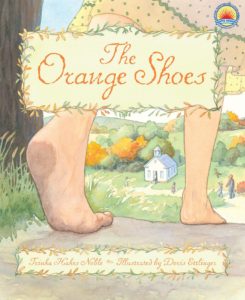 |
In Trinka Hakes Noble’s The Orange Shoes (Sleeping Bear Press, 2007), Delly Porter, who loves art, comes from a poor family and always walks barefoot to school. When her teacher, Miss Violet, comes up with a plan for a Shoebox Social to raise money for school art supplies, Delly’s father manages to buy her a new pair of orange shoes – which bullies on the playground do their best to destroy. Delly, however, with talent and paint, turns her shoes and shoebox into something beautiful. For ages 5-9. See this activity guide to accompany The Orange Shoes. |
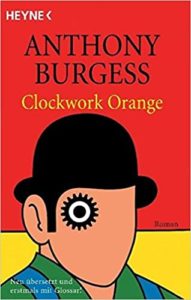 |
Anthony Burgess’s A Clockwork Orange (W.W. Norton, 2019) is a horrifying vision of the future narrated by Alex, sadistic leader of a violent teenage gang of droogs, who speaks in invented slang. Eventually Alex, apprehended and imprisoned for his crimes, is subjected to the Ludovico technique, a form of aversion therapy intended to convert him into a model citizen. For ages 15 and up. See these discussion questions to accompany A Clockwork Orange. |
YELLOW
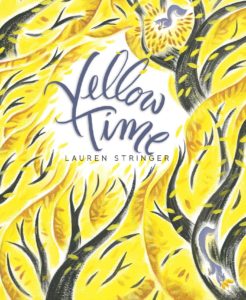 |
Lauren Stringer’s Yellow Time (Beach Lane Books, 2016) is a lovely celebration of the coming of autumn – the “yellow time.” For ages 3-6. |
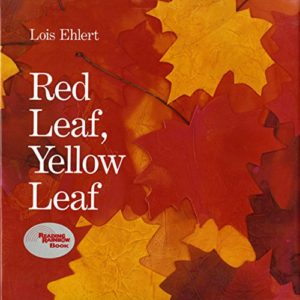 |
Lois Ehlert’s Red Leaf, Yellow Leaf (HMH, 1991) is the story of the life of a sugar maple tree. (Included are instructions for making a bird treat.) For ages 4-7. |
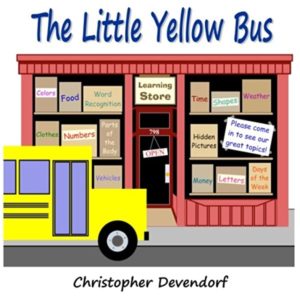 |
Christopher Devendorf’s The Little Yellow Bus (CreateSpace, 2010) is a multifaceted picture book in which readers are challenged to read words, identify shapes and colors, learn days of the week, and more. It begins with children boarding a bright-yellow school bus. For ages 4-7. |
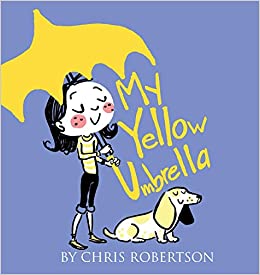 |
Chris Robertson’s My Yellow Umbrella is the story of an imaginative little girl and a yellow umbrella. (“My yellow umbrella is/warm like summer sun/Cozy like an afternoon nap/And happy like a picnic in the park.”) Will make everyone want a yellow umbrella. For ages 4-8. |
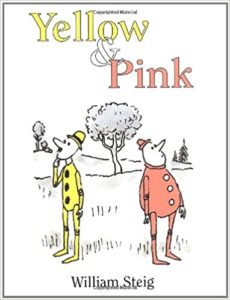 |
William Stieg’s Yellow and Pink (Square Fish, 1988) features a pair of puppets – one yellow and one pink – who debate their origins: are they the result of a series of natural processes or did someone create them? Discussion potential for ages 5-8. |
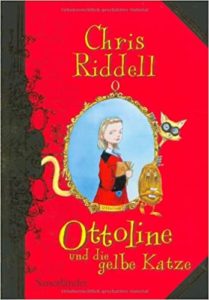 |
By Chris Riddell, Ottoline the Yellow Cat (Pan Macmillan, 2015) is the first of a chapter-book series starring Ottoline Brown, amateur detective, and her partner, Mr. Munroe, a strange little creature (from a Norwegian bog) who disguises himself as a dog. In this story, they come up against the nefarious Yellow Cat. Funny and clever, for ages 7-9. |
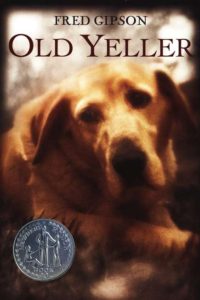 |
By Fred Gipson, Old Yeller (Harper Perennial, 2009), set in early frontier Texas, is the story of young Travis, left to care for family and farm while his father is off on a cattle drive. He does so with the help of a stray yellow dog, dubbed Old Yeller. A classic and a tearjerker for ages 10 and up. |
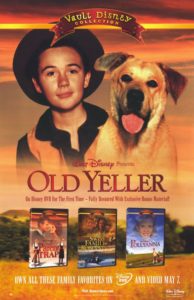 |
The 1957 Disney movie version of Old Yeller is rated “approved.” A wonderful dog. Just be prepared to cry. |
|
For more resources, see WOOF! All About Dogs. |
GREEN
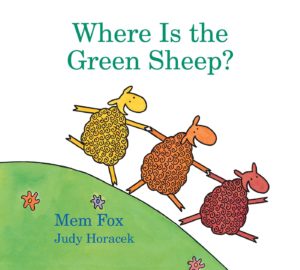 |
By Mem Fox, Where Is the Green Sheep? (Harcourt, 2004) is filled with colorful sheep – in the bath, in bed, on the slide, juggling balls, even on the moon – but where is the green sheep? For ages 3-7. |
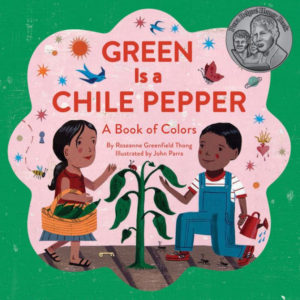 |
By Roseanne Greenfield Thong, Green is a Chile Pepper (Chronicle Books, 2016) is a rhyming book of Latino culture and colors. (Readers also learn the names of the colors in Spanish.) For ages 3-6. |
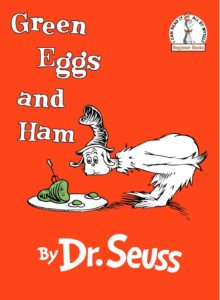 |
In Dr. Seuss’s classic Green Eggs and Ham (Random House, 1960), the main character insists to the persistent Sam-I-am, that he DOES NOT LIKE green eggs and ham. For ages 3-7. |
|
For more resources (and a green eggs and ham recipe), see EGGS. |
|
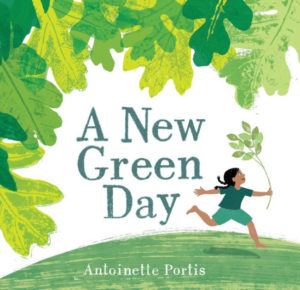 |
Antoinette Portis’s A New Green Day (Neal Porter Books, 2020) is a clever picture-book collection of poetic riddles about the natural world. (“I’m a map of my own/green home. Follow my roads, and climb”…says leaf.) For ages 3-7. |
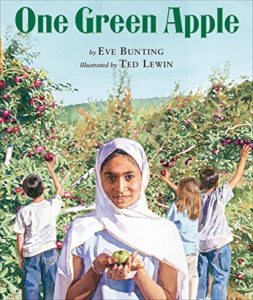 |
Eve Bunting’s One Green Apple (Clarion, 2006) is the story of Farah, a young Muslim immigrant just learning to speak English – who, on a class trip to a cider mill, puts a green apple rather than a red one into the cider press. The cider, however, is delicious – the lesson being that many different kinds of people blend together to make a better whole. For ages 4-8. |
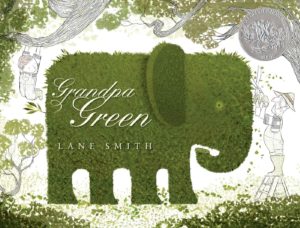 |
In Lane Smith’s Grandpa Green (Roaring Brook Press, 2011), a young boy tells the story of his great-grandfather’s life while wandering through his marvelous topiary garden. For ages 5-9. |
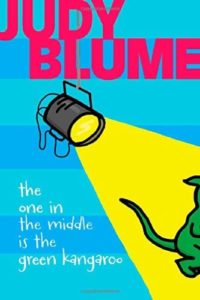 |
In Judy Blume’s The One In the Middle is the Green Kangaroo (Atheneum, 2014), Freddy Dissel feels squashed between his older brother Mike and younger sister Ellen – it’s hard being a middle kid – until he lands the part of the Green Kangaroo in the school play. For ages 6-9. |
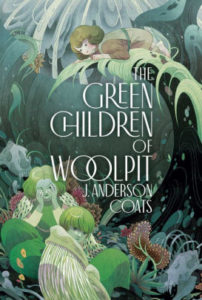 |
By J. Anderson Coats, The Green Children of Woolpit (Atheneum, 2020), based on a medieval English folk tale, is the story of two strange green children found in a wolf pit by twelve-year-old Agnes. The children are of the Fair Folk, there to convince dreamy and trusting Agnes to come to their underground world – which soon proves to be a dark and treacherous place. For ages 10 and up. |
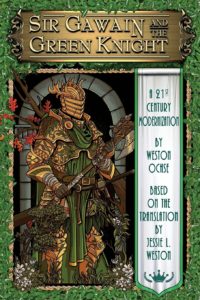 |
There are many available versions of the tale of Sir Gawain and the Green Knight, in which a mysterious knight, green from head to toe, challenges King Arthur’s knights of the Round Table to a dangerous duel. By Weston Ochise, Sir Gawain and the Green Knight (Dark Moon Books, 2021) is a modern translation of the classic story. For teens and adults. |
BLUE
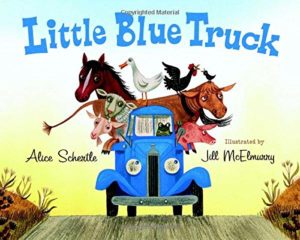 |
The main character of Alice Schertle’s Little Blue Truck (HMH, 2008) is an adorable little blue pick-up – who gets stuck in the mud trying to help a large mean dump truck, but is ultimately rescued with the help of a lot of farm animal friends. And the dump truck learns a lesson about friendship. For ages 4-7. |
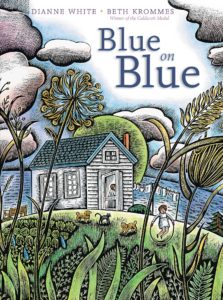 |
Dianne White’s Blue on Blue (Beach Lane Books, 2014) is a simple rhyming account of coming rain and thunderstorm, beautifully illustrated with scratchboard-and-watercolor pictures. (“Cotton clouds. Morning light./Blue on blue. White on white.”) For ages 4-8. |
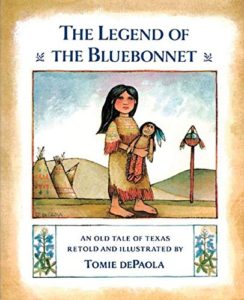 |
Tomie dePaola’s The Legend of the Bluebonnet (Puffin, 1996) is the picture-book version of a Comanche story in which a little girl sacrifices her most beloved possession to bring desperately needed rain to her people. For ages 4-8. |
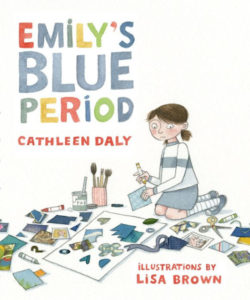 |
In Cathleen Daly’s Emily’s Blue Period (Neal Porter Books, 2014), Emily, a budding artist, is an admirer of Picasso – and when her parents divorce, she decides, like Picasso when he was sad, to paint only in blue. For ages 4-8. |
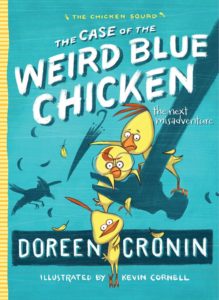 |
In Doreen Cronin’s The Case of the Weird Blue Chicken (Atheneum, 2016), one of the Chicken Squad series, the Chicken Squad – Dirt, Sugar, Poppy, and Sweetie – are out to solve mysteries and fight crime. This one involves a weird blue bird and a house-napping. For ages 6-10. |
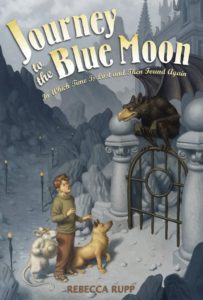 |
By Rebecca Rupp, Journey to the Blue Moon (Candlewick, 2006) is the story of a fantastical trip to the Blue Moon where all lost things go. Alex and his dog Zeke, with the help of some rambunctious Moon Rats and other lost travelers, are on a mission to find lost time. For ages 9-12. |
|
For more on blue (and other) moons, see THE MOON. |
|
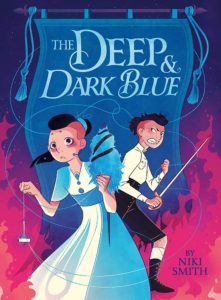 |
In Niki Smith’s graphic novel The Deep and Dark Blue (Little, Brown, 2020), twins Hawke and Grayson’s royal family has been destroyed in a political coup. Taking on new identities as Hanna and Grayce, the two find their way to the Communion of Blue, an order of magical women who spin the mystical threads that bind the world. For ages 10 and up. |
PURPLE
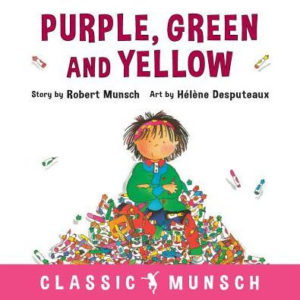 |
By Robert Munsch, Purple, Green and Yellow (Annick Press, 2018) is the story of Brigid, who wants washable markers, scented markers, and – oh-oh – “super-indelible, never-come-off-until-you’re-dead-and-maybe-even-later” markers. For ages 4-7. |
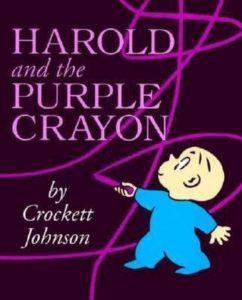 |
In Crockett Johnson’s Harold and the Purple Crayon (HarperCollins, 2015), Harold, armed with a magical purple crayon, goes for an imaginative walk in the moonlight. First he draws the moon – and next a long straight path, so that he won’t get lost. For ages 4-8. |
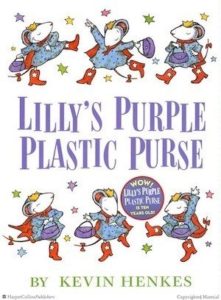 |
By Kevin Henkes, in Lilly’s Purple Plastic Purse (Greenwillow, 2006), Lilly’s most beloved possession is her purple plastic purse – which she can’t resist showing off, interrupting Mr. Slinger’s lesson about Types of Cheese. When her purse is confiscated, Lilly, furious, draws a picture of Big Fat Mean Mr. Stealing Teacher – but then she finds the understanding note that he left in her purse. For ages 4-8. |
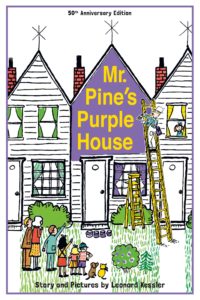 |
By Leonard Kessler, in Mr. Pine’s Purple House (Purple House Press, 2014), Mr. Pine lives in a street of plain white houses – so he decides to make his stand out. He paints it purple. For ages 4-8. |
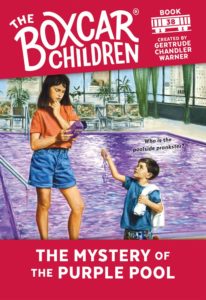 |
One of Gertrude Chandler Warner’s Boxcar Children series, in The Mystery of the Purple Pool (Albert Whitman & Company, 1994) the Alden kids go to New York City and tackle a mystery in their hotel – including a prankster who has dyed the hotel swimming pool purple. For ages 7-10. |
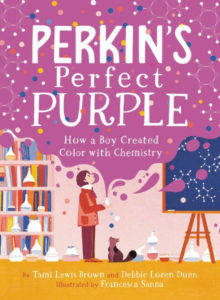 |
By Tami Lewis Brown and Debbie Loren Dunn, Perkin’s Perfect Purple (Little, Brown, 2020) is the story of how young chemist William Perkin failed at making a synthetic quinine – a drug used to treat malaria – but by mistake came up with purple aniline dyes. For ages 4-8. |
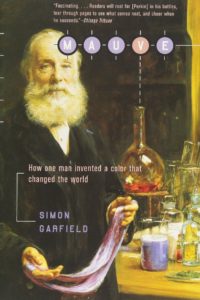 |
Simon Garfield’s Mauve: How One Man Invented a Color That Changed the World (W.W. Norton, 2002) is the story of Perkin and his marvelous purple dye for teens and adults. |
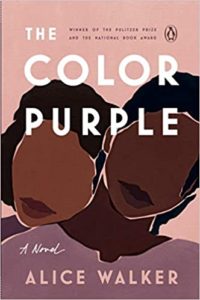 |
Alice Walker’s The Color Purple (Penguin, 2019) – winner of the Pulitzer Prize and National Book Award – is the story, told in letters, of two African American women, sisters, Celie and Nettie, in early 20th-century rural George. For teens and adults. |
